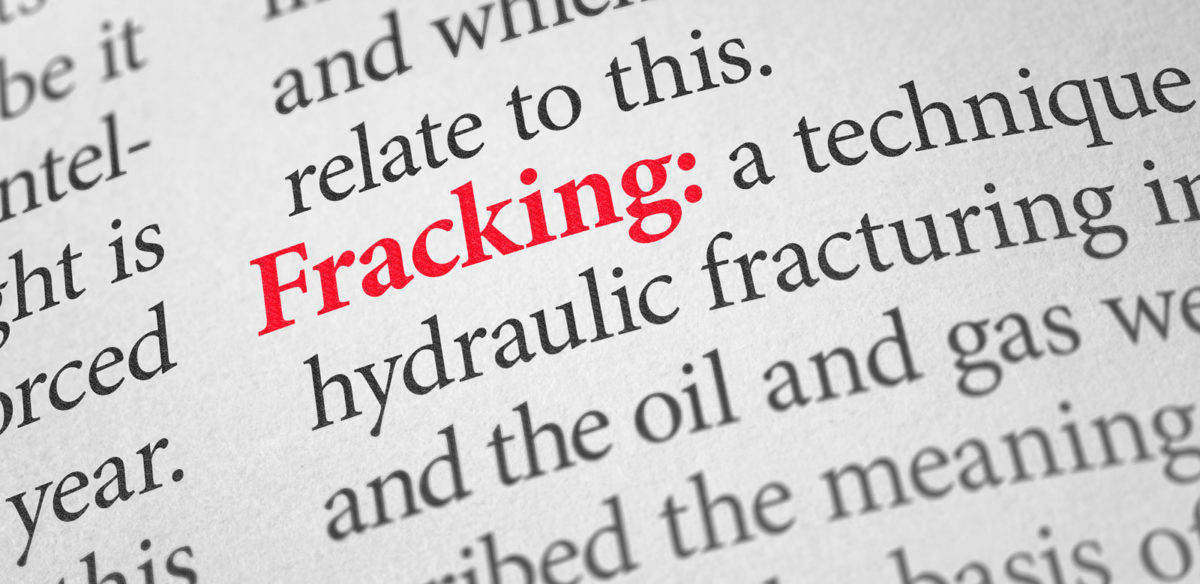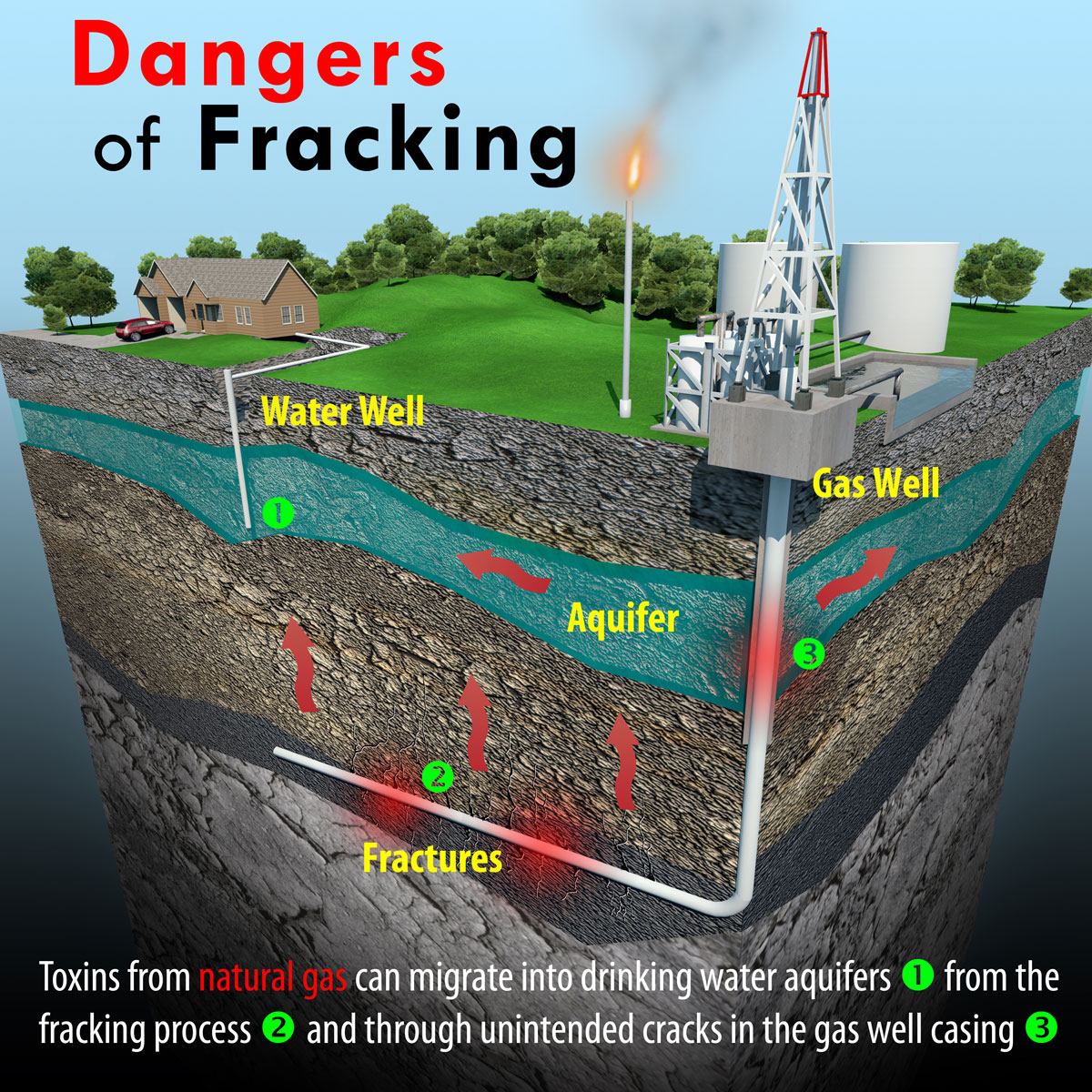The first communities across the country have adopted fracking bans with CELDF’s assistance. Below learn about the harms caused by fracking, how communities are organizing to stop them, and what you can do in your own community.
Hydraulic fracturing, or fracking, is a relatively new natural gas-extraction process, frequently utilized in recent years across the U.S. and around the world. The process requires the high-pressure injection of enormous quantities of water and toxic chemicals into shale formations deep underground. Fracking has been touted as a method to provide cheaper and cleaner energy to communities. In fact, its effects are expensive, harmful, and polluting.

What is Fracking?
Vast shale deposits stretch across America, from coast to coast. Known as shale plays, these deposits contain shale gas and oil – some of the largest reservoirs in the world – and lie deep under the surface.[1] The oil and gas industry is accessing these deposits, making the U.S. one of the largest producers of natural gas.
There are several phases of a hydraulic fracturing operation. The first is construction, whereby the landscape is torn apart to construct well pads, access roads, and other damaging infrastructure projects to meet the needs of the oil and gas industry. This often occurs nearby homes and schools, in the heart of communities.
The next step is drilling, which uses heavy machinery to drill wells that often extend 4,000 feet in length. The drilling process can bring intolerable and damaging noise levels.
This is followed by what is termed fracturing and completion: pumping a staggering quantity of water and toxic chemical additives down the drilled well under high pressure, followed by the ‘flowback’ of toxic fluids and natural gas.
Lastly is the production phase, which involves the removal of equipment, partial reclamation of the well pad, and installation of equipment and pipelines to capture and transmit the natural gas to compressor stations, gathering lines and, often, to export terminals.[2,3]

Water Waste and a Waste of Water
Wells for fracking use massive amounts of water— between 1 and 8 million gallons (200 tanker trucks). What doesn’t come back up as flowback stays in the ground, and typically contains chemicals, metals and radioactive material that can pollute local water sources and cause harm to human and natural communities.[4] The contamination of drinking water also occurs frequently after a well is fracked. In New Mexico alone, waste pits from oil and gas drilling have contaminated groundwater on more than 400 occasions. Groundwater near fracking sites has been found to contain methane levels 17 times the normal level.[4,5] There have even been reports from residents living near fracking wells that the water from their faucets is flammable.[4]
The Pennsylvania Department of Environmental Protection recently released findings that oil and gas practices have harmed private water supplies in the state 209 times since the end of 2007.[7] Additionally, the fracking industry is exempt from the Safe Drinking Water Act, and is not required to disclose chemicals used during the process because of a federal law adopted in 2005.[6]
Effects on the Air, Globally and Locally
While fracking occurs underground, the process nevertheless harms air quality, affecting respiratory health due to increased levels of particulate matter, diesel exhaust, and volatile organic chemicals, as well as methane leakage from well pads, and dust and benzene from idling trucks. These emissions can also cause respiratory health conditions such as asthma, as well as odor problems.[1]
Fracking contributes to global warming, as methane and other volatile organic chemicals are released into the atmosphere – making it a global problem, as well as a local one. Reports indicate fracking could increase ozone levels by 1 to 3 parts per billion in areas downwind of fracking operations, which is considered a significant harm.[10]
Earthquakes
Hydraulic fracking pumps a mixture of water, sand, and toxic chemicals under high pressure into the shale formations. In doing so, fracking produces numerous long, narrow fractures in the rock formation. These fractures make the ground unstable, which can result in earthquakes.
A recent study ascribed a series of earthquakes in Poland, Ohio, to high-volume hydraulic fracturing operations. Between March 4 and March 12, 2014, 77 earthquakes, ranging between 1.0 and 3.0 in magnitude, were identified and found to be closely related spatially and temporally to hydraulic fracturing operations at a nearby well. After the Ohio Department of Natural Resources ordered the high-volume hydraulic fracturing well to be shut down on March 10, 2014, the rate decreased until the earthquakes stopped.[10]
It’s not just Ohio. Between 2009 and 2011, 38 earthquakes, including one of a 3.8 magnitude, resulted from hydraulic fracturing in the Horn River Basin shale gas reservoir in northeast British Columbia.[8] Fracking related earthquakes have been reported as well in Colorado, Oklahoma, and Texas.[11,12]
Bad for Communities
The hydraulic fracturing industry spreads propaganda that says fracking creates a thriving, local economy in small communities. The reality on the ground reveals otherwise. Community harms associated with boom-town economic effects include increased vehicle traffic, road damage, noise, odor complaints, increased demand for housing and medical care, and higher stress levels.[1] Frequently reported health problems from those who live near fracking sites include neurological effects, skin rash or irritation, nausea or vomiting, abdominal pain, breathing difficulties or cough, nosebleeds, anxiety, headache, dizziness, elevated crystalline silica exposure and eye and throat irritation in people and farm animals.[9] It’s also been documented that close proximity to fracking well pads is linked to low birth weight, congenital heart defects and neural-tube defects.[1]
Beyond the negative health impacts of living near an industrialized fracking operation, other harms are also common. Natural gas pipelines, gathering lines, compressor stations and other infrastructure invade the landscape, lowering property values and tearing up the land.[10] Industrialized fracking also threatens cultural, historical, and natural resources, which can cause a dramatic decrease in tourism, community character and socioeconomics.
There is also the issue of simply having too many people in a smaller community. Over congestion adds to the risk of accidents. A recent study from Pennsylvania reports that automobile and truck accident rates in 2010–2012 from counties with heavy fracking activity were between 15% and 65% higher than accident rates in counties without fracking. Traffic fatalities were higher as well.[1]
Your Community Can Take Action
In November 2010, CELDF worked with the City of Pittsburgh to become the first community in the nation to ban hydraulic fracking. By a unanimous vote, the city council adopted the CELDF-drafted Community Bill of Rights ordinance banning shale gas drilling and fracking, and establishing community and nature’s rights. Since then, CELDF has partnered with communities in Pennsylvania, Ohio, Maryland, New York, and New Mexico to develop first-in-the-nation laws banning corporations from fracking and securing the rights of community self-governance.
Take action. Stand up to Fracking.
If you or your community is threatened by fracking, or trying to stop a fracking operation from establishing itself in your community, contact CELDF and learn how to take action. You and your community have rights, and CELDF is here to help you fight for them.
Sources
[1] Zucker, Howard A. A Public Health Review of High Volume Hydraulic Fracturing for Shale Gas Development. Rep. New York State Department of Health, Dec. http://www.health.ny.gov/press/reports/docs/high_volume_hydraulic_fracturing.pdf
[2] Final Supplemental Generic Environmental Impact Statement on the Oil, Gas and Solution Mining Regulatory Program. Findings Statement. New York Department of Environmental Conservation. June 2015. http://www.dec.ny.gov/docs/materials_minerals_pdf/findingstatehvhf62015.pdf
[3] http://www.dec.ny.gov/docs/materials_minerals_pdf/findingstatehvhf62015.pdf (page 22)
[4] http://www.treehugger.com/fossil-fuels/facts-on-fracking-pros-cons-of-hydraulic-fracturing-for-natural-gasinfographic.html
[5] http://www.environmentamerica.org/sites/environment/files/reports/EA_FrackingNumbers_scrn.pdf
[6] Holzman, David C. “Methane found in well water near fracking sites.”Environmental health perspectives 119.7 (2011): a289. http://www.ncbi.nlm.nih.gov/pmc/articles/PMC3222989/
[7] http://mediamatters.org/research/2014/08/06/study-top-fracking-states-ignore-findings-that/200339
[8] http://www.health.ny.gov/press/reports/docs/high_volume_hydraulic_fracturing.pdf
[9] http://www.dec.ny.gov/docs/materials_minerals_pdf/findingstatehvhf62015.pdf & http://www.health.ny.gov/press/reports/docs/high_volume_hydraulic_fracturing.pdf
[10] http://www.dec.ny.gov/docs/materials_minerals_pdf/findingstatehvhf62015.pdf
[11] http://news.nationalgeographic.com/news/energy/2014/05/140502-scientists-warn-of-quake-risk-from-fracking-operations/
[12] https://stateimpact.npr.org/texas/tag/earthquake/
